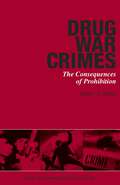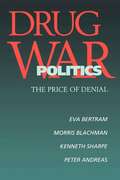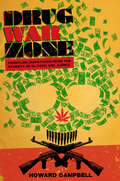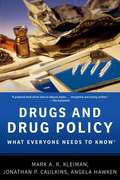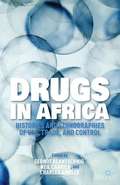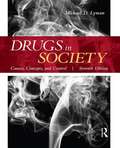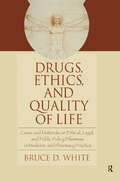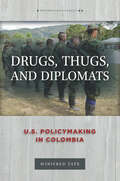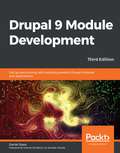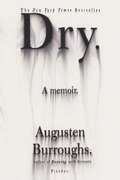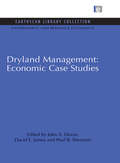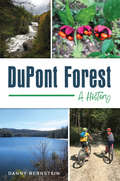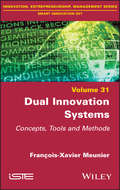- Table View
- List View
Drug War Crimes: The Consequences of Prohibition
by Jeffrey A. MironA balanced and sophisticated analysis of the true costs, benefits, and consequences of enforcing drug prohibition.The "War on Drugs" claims thousands of lives every year in the United States. Each year, the U.S. government spends over $30 billion on the drug war and arrests 1.5 million American citizens on drug-related charges. There are now nearly half a million Americans imprisoned for drug offenses. The official claim is that drug prohibition deters drug use, reduces crime, and improves public health. But is this claim valid? In Drug War Crimes, Jeffrey Miron offers a balanced and sophisticated analysis of the true costs, benefits, and consequences of drug prohibition. The evidence yields a disturbing finding: the more resources given to the Drug War, the greater the homicide rate. Miron then examines various alternatives to drug prohibition and identifies the most effective solution.
Drug War Politics: The Price Of Denial (Emersion: Emergent Village Resources For Communities Of Faith Ser.)
by Peter Andreas Kenneth Sharpe Eva Bertram Morris BlachmanWhy have our drug wars failed and how might we turn things around? Ask the authors of this hardhitting exposè of U.S. efforts to fight drug trafficking and abuse. In a bold analysis of a century's worth of policy failure, Drug War Politics turns on its head many familiar bromides about drug politics. It demonstrates how, instead of learning from our failures, we duplicate and reinforce them in the same flawed policies. The authors examine the "politics of denial" that has led to this catastrophic predicament and propose a basis for a realistic and desperately needed solution. Domestic and foreign drug wars have consistently fallen short because they are based on a flawed model of force and punishment, the authors show. The failure of these misguided solutions has led to harsher get-tough policies, debilitating cycles of more force and punishment, and a drug problem that continues to escalate. On the foreign policy front, billions of dollars have been wasted, corruption has mushroomed, and human rights undermined in Latin America and across the globe. Yet cheap drugs still flow abundantly across our borders. At home, more money than ever is spent on law enforcement, and an unprecedented number of people―disproportionately minorities―are incarcerated. But drug abuse and addiction persist. The authors outline the political struggles that help create and sustain the current punitive approach. They probe the workings of Washington politics, demonstrating how presidential and congressional "out-toughing" tactics create a logic of escalation while the criticisms and alternatives of reformers are sidelined or silenced. Critical of both the punitive model and the legalization approach, Drug War Politics calls for a bold new public health approach, one that frames the drug problem as a public health―not a criminal―concern. The authors argue that only by situating drug issues in the context of our fundamental institutions―the family, neighborhoods, and schools―can we hope to provide viable treatment, prevention, and law enforcement. In its comprehensive investigation of our long, futile battle with drugs and its original argument for fundamental change, this book is essential for every concerned citizen.
Drug War Zone: Frontline Dispatches from the Streets of El Paso and Juárez (The William & Bettye Nowlin Series in Art, History, and Culture of the Western Hemisphere)
by Howard CampbellThousands of people die in drug-related violence every year in Mexico. Ciudad Juárez, Chihuahua, adjacent to El Paso, Texas, has become the most violent city in the Mexican drug war. Much of the cocaine, marijuana, and methamphetamine consumed in the United States is imported across the Mexican border, making El Paso/Juárez one of the major drug-trafficking venues in the world. In this anthropological study of drug trafficking and anti-drug law enforcement efforts on the U. S. -Mexico border, Howard Campbell uses an ethnographic perspective to chronicle the recent Mexican drug war, focusing especially on people and events in the El Paso/Juárez area. It is the first social science study of the violent drug war that is tearing Mexico apart. Based on deep access to the drug-smuggling world, this study presents the drug war through the eyes and lives of direct participants. Half of the book consists of oral histories from drug traffickers, and the other half from law enforcement officials. There is much journalistic coverage of the drug war, but very seldom are the lived experiences of traffickers and "narcs" presented in such vivid detail. In addition to providing an up-close, personal view of the drug-trafficking world, Campbell explains and analyzes the functioning of drug cartels, the corruption that facilitates drug trafficking, the strategies of smugglers and anti-narcotics officials, and the perilous culture of drug trafficking that Campbell refers to as the "Drug War Zone. "
Drug Wars: How Big Pharma Raises Prices and Keeps Generics off the Market
by Robin Feldman Evan FrondorfWhile the shockingly high prices of prescription drugs continue to dominate the news, the strategies used by pharmaceutical companies to prevent generic competition are poorly understood, even by the lawmakers responsible for regulating them. In this groundbreaking work, Robin Feldman and Evan Frondorf illuminate the inner workings of the pharmaceutical market and show how drug companies twist health policy to achieve goals contrary to the public interest. In highly engaging prose, they offer specific examples of how generic competition has been stifled for years, with costs climbing into the billions and everyday consumers paying the price. Drug Wars is a guide to the current landscape, a roadmap for reform, and a warning of what is to come. It should be read by policymakers, academics, patients, and anyone else concerned with the soaring costs of prescription drugs.
Drugs and Drug Policy: What Everyone Needs to Know
by Mark A. R. Kleiman Jonathan P. Caulkins Angela HawkenWhile there have always been norms and customs around the use of drugs, explicit public policies - regulations, taxes, and prohibitions - designed to control drug abuse are a more recent phenomenon. Those policies sometimes have terrible side-effects: most prominently the development ofcriminal enterprises dealing in forbidden (or untaxed) drugs and the use of the profits of drug-dealing to finance insurgency and terrorism. Neither a drug-free world nor a world of free drugs seems to be on offer, leaving citizens and officials to face the age-old problem: What are we going to do about drugs? In Drugs and Drug Policy, three noted authorities survey the subject with exceptional clarity, in this addition to the acclaimed series, What Everyone Needs to Know. They begin by, defining "drugs," examining how they work in the brain, discussing the nature of addiction, and exploring the damage they do to users. The book moves on to policy, answering questions about legalization, the role of criminal prohibitions, and the relative legal tolerance for alcohol and tobacco. The authors then dissect the illicit trade, from street dealers to the flow of money to the effect of catching kingpins,and show the precise nature of the relationship between drugs and crime. They examine treatment, both its effectiveness and the role of public policy, and discuss the beneficial effects of some abusable substances. Finally they move outward to look at the role of drugs in our foreign policy, their relationship to terrorism, and the ugly politics that surround the issue. Crisp, clear, and comprehensive, this is a handy and up-to-date overview of one of the most pressing topics in today's world.
Drugs and Money: Managing the Drug Trade and Crime Money in Europe
by Michael Levi Petrus C. van DuyneThe phenomenon of psycho-active drugs, and our reactions to them, is one of the most fascinating topics of the social history of mankind. Starting with an analysis of the 'policy of fear' in which law enforcement is 'haunted' by drug money, Drugs and Money offers a radical reconsideration of this highly contentious issue.In this intriguing book, Petrus C. van Duyne and Michael Levi expose an ever-unfolding series of problems: the proliferation of mind-influencing substances the complications of international drug regulation the interaction between markets and economic actors, with the consequent amassing of huge amounts of crime-money. The social, cultural and economic aspects of this crime-money are explored, alongside the ongoing threat it poses to the legitimate economy and the state.
Drugs in Africa
by Gernot Klantschnig Neil Carrier Charles AmblerThis cutting-edge volume is the first to address the burgeoning interest in drugs and Africa among scholars, policymakers, and the general public. It brings together an interdisciplinary group of leading academics and practitioners to explore the use, trade, production, and control of mind-altering substances on the continent
Drugs in Society: Causes, Concepts, and Control
by Michael D. LymanThis work focuses on the many critical areas of America's drug problem, providing a foundation for rational decision making within this complex and multidisciplinary field. Broken up into three sections, Understanding the Problem, Gangs and Drugs, and Fighting Back, topics covered include the business of drugs and the role of organized crime in the drug trade, drug legalization and decriminalization, legal and law enforcement strategies, an analysis of the socialization process of drug use and abuse, and a historical discussion of drug abuse that puts the contemporary drug problem into perspective.
Drugs, Ethics, and Quality of Life: Cases and Materials on Ethical, Legal, and Public Policy Dilemmas in Medicine and Pharmacy Practice
by Bruce D. WhiteWeigh pivotal healthcare ethics, law, and public policy issues that resulted in tipping-point legal actionsWeighing the ethical considerations in healthcare and drug issues can be emotionally difficult and mentally challenging. Drugs, Ethics, and Quality of Life: Cases and Materials on Ethical, Legal, and Public Policy Dilemmas in Medicine and Pharmacy Practice is a fascinating casebook that clearly discusses the most contentious ethical conflicts that resulted in legal actions. This easy-to-read text provides all sides of controversial real-life cases that provoke spirited debate while teaching the fundamentals of pharmacy law and ethics. The book is a unique exploration into the basic principles of bioethics, end of life care, and drug research. Drugs, Ethics, and Quality of Life explains in detail the concepts of ethics, quality of life, beneficence, nonmaleficence, autonomy, and justice. Recent cases provide illuminating backdrops for the exploration of these concepts, making them easily understood. A special introduction includes important information about ethics and the pharmaceutical code of ethics. Two appendixes provide further opportunities for discussion and the examination of law and decisions, and resources about drug use decisions and situations. This thought-provoking textbook plainly shows the crucial role ethics plays in today&’s society. Ethical topics explored in Drugs, Ethics, and Quality of Life includes legal cases on: tobacco COX-2 inhibitors medical marijuana the "morning after" pill and other emergency contraceptives pain medications and palliative care drugs physician-assisted suicide drug use in medically futile situations gene therapy Drugs, Ethics, and Quality of Life is valuable, insightful reading as well as a good adjunct text for pharmacy students, pharmacists, medical students, physicians, bio
Drugs, Thugs, and Diplomats: U.S. Policymaking in Colombia
by Winifred TateIn 2000, the U. S. passed a major aid package that was going to help Colombia do it all: cut drug trafficking, defeat leftist guerrillas, support peace, and build democracy. More than 80% of the assistance, however, was military aid, at a time when the Colombian security forces were linked to abusive, drug-trafficking paramilitary forces. Drugs, Thugs, and Diplomats examines the U. S. policymaking process in the design, implementation, and consequences of Plan Colombia, as the aid package came to be known. Winifred Tate explores the rhetoric and practice of foreign policy by the U. S. State Department, the Pentagon, Congress, and the U. S. military Southern Command. Tate's ethnography uncovers how policymakers' utopian visions and emotional entanglements play a profound role in their efforts to orchestrate and impose social transformation abroad. She argues that U. S. officials' zero tolerance for illegal drugs provided the ideological architecture for the subsequent militarization of domestic drug policy abroad. The U. S. also ignored Colombian state complicity with paramilitary brutality, presenting them as evidence of an absent state and the authentic expression of a frustrated middle class. For rural residents of Colombia living under paramilitary dominion, these denials circulated as a form of state terror. Tate's analysis examines how oppositional activists and the policy's targets--civilians and local state officials in southern Colombia--attempted to shape aid design and delivery, revealing the process and effects of human rights policymaking.
Drugs: America's Holy War
by Arthur BenavieUsing the best scientific evidence, Drugs: America's Holy War explores the impact and cost of America's "War on Drugs" - both in tax spending and in human terms. Is it possible that US drug policies are helping to proliferate, not prevent, a multitude of social ills including: homicide, property crime, the spread of AIDS, the contamination of drugs, the erosion of civil liberties, the punishment of thousands of non-violent people, the corruption of public officials, and the spending of billions of tax dollars in an attempt to prevent certain drugs from entering the country? In this controversial new book, award-winning economist Arthur Benavie analyzes the research findings and argues that an end to the war on drugs, much as we ended alcohol prohibition, would yield enormous international benefits, destroy dangerous and illegal drug cartels, and allow the American government to refocus its attention on public well-being.
Drupal 9 Module Development: Get up and running with building powerful Drupal modules and applications, 3rd Edition
by Daniel Sipos Antonio De MarcoBuild and extend flexible Drupal sites and applications with this up-to-date, expert guide to Drupal 9 module development Key Features Explore the essential Drupal 9 APIs for module development Learn how to implement data modeling, caching, architecture, and much more in your Drupal applications Discover what's new in the latest Drupal core releases Book Description With its latest release, Drupal 9, the popular open source CMS platform has been updated with new functionalities for building complex Drupal apps with ease. This third edition of the Drupal Module Development guide covers these new Drupal features, helping you to stay on top of code deprecations and the changing architecture with every release. The book starts by introducing you to the Drupal 9 architecture and its subsystems before showing you how to create your first module with basic functionality. You'll explore the Drupal logging and mailing systems, learn how to output data using the theme layer, and work with menus and links programmatically. Once you've understood the different kinds of data storage, this Drupal guide will demonstrate how to create custom entities and field types and leverage the Database API for lower-level database queries. You'll also learn how to introduce JavaScript into your module, work with various file systems, and ensure that your code works on multilingual sites. Finally, you'll work with Views, create automated tests for your functionality, and write secure code. By the end of the book, you'll have learned how to develop custom modules that can provide solutions to complex business problems, and who knows, maybe you'll even contribute to the Drupal community! What you will learn Develop custom Drupal 9 modules for your applications Master different Drupal 9 subsystems and APIs Model, store, manipulate, and process data for effective data management Display data and content in a clean and secure way using the theme system Test your business logic to prevent regression Stay ahead of the curve and write PHP code by implementing best practices Who this book is for If you are a Drupal developer looking to learn Drupal 9 to write modules for your sites, this book is for you. Drupal site builders and PHP developers with basic object-oriented programming skills will also find this book helpful. Although not necessary, some Symfony experience will help with understanding concepts easily.
Dry: A Memoir
by Augusten Burroughs<P>You may not know it, but you've met Augusten Burroughs. You've seen him on the street, in bars, on the subway, at restaurants: a twenty-something guy, nice suit, works in advertising. Regular. Ordinary. <P>But when the ordinary person had two drinks, Augusten was circling the drain by having twelve; when the ordinary person went home at midnight, Augusten never went home at all. <P>Loud, distracting ties, automated wake-up calls, and cologne on the tongue could only hide so much for so long. <P>At the request (well, it wasn't really a request) of his employers, Augusten landed in rehab, where his dreams of group therapy with Robert Downey, Jr., are immediately dashed by the grim reality of fluorescent lighting and paper hospital slippers. <P>But when Augusten is forced to examine himself, something actually starts to click, and that's when he finds himself in the worst trouble of all. <P>Because when his thirty days are up, he has to return to his same drunken Manhattan life-and live it sober. What follows is a memoir that's as moving as it is funny, as heartbreaking as it is real. <P>Dry is the story of love, loss, and Starbucks as a higher power. <P><b>A New York Times Bestseller</b>
Dryland Management: Economic Case Studies (Environmental and Resource Economics Set)
by David E. James John A. Dixon Paul B. ShermanDrylands are a sizeable part of the world's potentially arable land. They vary from the hyper-arid regions of the classic deserts of Africa and Asia to the more common semi-arid and sub-humid areas that support extensive agricultural systems dependent on rainfall or irrigation. Following their successful and innovative work The Economics of Dryland Management the editors have assembled twenty case studies from nine countries in the continents of Africa, Asia, North America and Australia. They help to explore more fully the costs of land degradation and illustrate the economics of reclamation, rehabilitation and prevention. The cases in this book present a rich, varied and readable survey of a wide range of drylands and their resources. Originally published in 19990
Du Pont Dynasty: Behind the Nylon Curtain (Forbidden Bookshelf #6)
by Gerard ColbyAward-winning journalist Gerard Colby takes readers behind the scenes of one of America&’s most powerful and enduring corporations; now with a new introduction by the author Their name is everywhere. America&’s wealthiest industrial family by far and a vast financial power, the Du Ponts, from their mansions in northern Delaware&’s &“Chateau Country,&” have long been leaders in the relentless drive to turn the United States into a plutocracy. The Du Pont story in this country began in 1800. Éleuthère Irénée du Pont, official keeper of the gunpowder of corrupt King Louis XVI, fled from revolutionary France to America. Two years later he founded the gunpowder company that called itself &“America&’s armorer&”—and that President Wilson&’s secretary of war called a &“species of outlaws&” for war profiteering. Du Pont Dynasty introduces many colorful characters, including &“General&” Henry du Pont, who profited from the Civil War to build the Gunpowder Trust, one of the first corporate monopolies; Alfred I. du Pont, betrayed by his cousins and pushed out of the organization, landing in social exile as the powerful &“Count of Florida&”; the three brothers who expanded Du Pont&’s control to General Motors, fought autoworkers&’ right to unionize, and then launched a family tradition of waging campaigns to destroy FDR&’s New Deal regulatory reforms; Governor Pete du Pont, who ran for president and backed Newt Gingrich&’s 1994 Republican Revolution; and Irving S. Shapiro, the architect of Du Pont&’s ongoing campaign to undermine effective environmental regulation. From plans to force President Roosevelt from office, to munitions sales to warlords and the rising Nazis, to Freon&’s damage to the planet&’s life-protecting ozone layer, to the manufacture of deadly gases and the covered-up poisoning of Du Pont workers, to the reputation the company earned for being the worst polluter of America&’s air and water, the Du Pont reign has been dappled with scandal for centuries. Culled from years of painstaking research and interviews, this fully documented book unfolds like a novel. Laying bare the bitter feuds, power plays, smokescreens, and careless unaccountability that erupted in murder, Colby pulls back the curtain on a dynasty whose formidable influence continues to this day. Suppressed in myriad ways and the subject of the author&’s landmark federal lawsuit, Du Pont Dynasty is an essential history of the United States.
Du Pont Dynasty: Behind the Nylon Curtain (Forbidden Bookshelf #6)
by Gerard ColbyAward-winning journalist Gerard Colby takes readers behind the scenes of one of America&’s most powerful and enduring corporations; now with a new introduction by the author Their name is everywhere. America&’s wealthiest industrial family by far and a vast financial power, the Du Ponts, from their mansions in northern Delaware&’s &“Chateau Country,&” have long been leaders in the relentless drive to turn the United States into a plutocracy. The Du Pont story in this country began in 1800. Éleuthère Irénée du Pont, official keeper of the gunpowder of corrupt King Louis XVI, fled from revolutionary France to America. Two years later he founded the gunpowder company that called itself &“America&’s armorer&”—and that President Wilson&’s secretary of war called a &“species of outlaws&” for war profiteering. Du Pont Dynasty introduces many colorful characters, including &“General&” Henry du Pont, who profited from the Civil War to build the Gunpowder Trust, one of the first corporate monopolies; Alfred I. du Pont, betrayed by his cousins and pushed out of the organization, landing in social exile as the powerful &“Count of Florida&”; the three brothers who expanded Du Pont&’s control to General Motors, fought autoworkers&’ right to unionize, and then launched a family tradition of waging campaigns to destroy FDR&’s New Deal regulatory reforms; Governor Pete du Pont, who ran for president and backed Newt Gingrich&’s 1994 Republican Revolution; and Irving S. Shapiro, the architect of Du Pont&’s ongoing campaign to undermine effective environmental regulation. From plans to force President Roosevelt from office, to munitions sales to warlords and the rising Nazis, to Freon&’s damage to the planet&’s life-protecting ozone layer, to the manufacture of deadly gases and the covered-up poisoning of Du Pont workers, to the reputation the company earned for being the worst polluter of America&’s air and water, the Du Pont reign has been dappled with scandal for centuries. Culled from years of painstaking research and interviews, this fully documented book unfolds like a novel. Laying bare the bitter feuds, power plays, smokescreens, and careless unaccountability that erupted in murder, Colby pulls back the curtain on a dynasty whose formidable influence continues to this day. Suppressed in myriad ways and the subject of the author&’s landmark federal lawsuit, Du Pont Dynasty is an essential history of the United States.
Du Pont Freon Products Division (A)
by Richard H.K. Vietor Forest ReinhardtIn 1988, the Du Pont Co. is abruptly confronted with solid scientific evidence that chlorofluorocarbons are destroying the earth's ozone shield. Du Pont, with its Freon brand product line serving markets for foam insulation, electronics solvents, and especially refrigeration, was the world's leading producer of these chemicals. Although no substitutes were currently commercially available, or even proven, Du Pont had to decide what to do. The purpose of the case is to examine how changing science and environmental problems affect competitive conditions and corporate strategy. In particular, the case examines the criteria by which companies formulate policy.
Du Pont Kevlar Aramid Industrial Fiber (Abridged)
by Clayton M. ChristensenDescribes Dupont's efforts to build commercial markets for its miracle fiber, Kevlar. Initially, it sought to create a market for Kevlar tire cord, primarily because its existing tire cord business was languishing. This market never developed, even after Dupont spent several hundred million dollars. A rewritten version of an earlier case.
Du Pont Kevlar Aramid Industrial Fiber (Abridged)
by Clayton M. Christensen Rory McdonaldDescribes Dupont's efforts to build commercial markets for its miracle fiber, Kevlar. Initially, it sought to create a market for Kevlar tire cord, primarily because its existing tire cord business was languishing. This market never developed, even after Dupont spent several hundred million dollars. A rewritten version of an earlier case.
Du Pont's Titanium Dioxide Business (A)
by Pankaj GhemawatThis case series is a vehicle for examining the strategic logic and risks of preemption. Rewritten versions of earlier cases.
Du bist - nicht so, wie Du denkst!: Eine didaktische Theorie zur haltungsorientierten Persönlichkeitsbildung (Pedaktik)
by Christoph RöckeleinIn diesem Buch wird die didaktische Basistheorie einer haltungsorientierten Persönlichkeitsbildung in ihren einzelnen Elementen vorgestellt und am Schluss des Buches im Handlungsfeld des haltungsbasierten Coaching gezeigt. Im Kontext der von Christoph Röckelein konzipierten Pedaktik liegt der Schwerpunkt des Interesses auf der Coaching- bzw. der Beratungssituation, also auf persönlichkeitsbildenden Interaktionen. Das Innovative des pedaktischen Ansatzes ist, dass die Haltung im Fokus der Persönlichkeitsbildung steht. Diese Bildungsarbeit kann nur gelingen, wenn der Coach die Haltung, die er vermitteln will, selbst internalisiert hat. Diese Form der Interaktion könnte man auch als (Hin-)Führung zur Selbstführung bezeichnen.
DuPont Forest: A History (Natural History)
by Danny BernsteinDuPont Forest protects thousands of acres of trees, five lakes and more than one hundred miles of multiuse trails. It attracts hikers, equestrians and mountain bikers from all over the United States, and its six waterfalls have been featured in movies like The Hunger Games and The Last of the Mohicans. All of this natural beauty is easily accessible, increasing its appeal. It took not only the generosity of a multinational company but also Southern Appalachian grit and self-reliance and local activism to make these benefits available to all. DuPont Forest is young, and its future is still unfolding. Author and hiker Danny Bernstein traces the past of DuPont State Recreational Forest and shows its potential.
Dual Career Service: Ein innovatives Instrument zur Personalrekrutierung und Mitarbeiterbindung (essentials)
by Doris BrennerIm Mittelpunkt des Buches steht, wie Sie Ihre Attraktivität als Arbeitgeber bei der Zielgruppe der qualifizierten Fach- und Führungskräfte steigern können. Häufig springen Bewerber ab bzw. lassen Mitarbeiter interne Entwicklungsmöglichkeiten ungenutzt, weil es für ihre Lebenspartner keine beruflichen Perspektiven am neuen Standort gibt. Mit Dual Career Service Angeboten gelingt es Ihnen als Arbeitgeber, die Partner mit ins Boot zu nehmen und diese aktiv zu unterstützen. Damit verschaffen Sie sich einen entscheidenden Wettbewerbsvorteil. Denn: Leistungen zur besseren Vereinbarkeit von beruflicher Entwicklung beider Partner und privater Partnerschaft stehen bei der Zielgruppe sehr hoch im Kurs.
Dual Identity: Indians as Customers, Competitors, and Collaborators--Working with India's Multinationals
by Nirmalya Kumar Pradipta K. Mohapatra Suj ChandrasekharThere is a subtle reason why it rarely occurs to most people to view Indian business practices as being as unique as those of China or Japan. According to the authors, Indians are proficient at adopting dual identities. When Indians encounter foreigners, especially Westerners, they adopt markers of global identity and dress, food, and even consumption of cultural products. But Indians, despite their apparent Western business outlook, do have some distinct tendencies in how they approach business. As Indian companies become increasingly powerful competitors on the global stage, it is important to understand how Indian companies play the roles of customers, competitors, and collaborators. This chapter is excerpted from "India's Global Powerhouses: How They Are Taking on the World."
Dual Innovation Systems: Concepts, Tools and Methods
by Francois-Xavier MeunierTechnical superiority is one of the keys to military domination. Thus, defense industries have supported the development of increasingly efficient systems and made significant contributions to technical progress. However, since the late 1980s, defense industries' technological initiative has been questioned and new sources of innovation have been sought by turning to the civilian sphere. A duality was born from this marriage of defense and civil innovation which developed their synergies in order to improve the innovation process in both areas. Dual Innovation Systems uses a systemic approach to investigate this dual approach to innovation and how it promotes improvements in the research and development processes of the defense and civilian areas. It also presents a variety of tools for measuring the performance of a dual innovation system.
